Chen Zhou
A Large-scale Benchmark on Geological Fault Delineation Models: Domain Shift, Training Dynamics, Generalizability, Evaluation and Inferential Behavior
May 13, 2025Abstract:Machine learning has taken a critical role in seismic interpretation workflows, especially in fault delineation tasks. However, despite the recent proliferation of pretrained models and synthetic datasets, the field still lacks a systematic understanding of the generalizability limits of these models across seismic data representing a variety of geologic, acquisition and processing settings. Distributional shifts between different data sources, limitations in fine-tuning strategies and labeled data accessibility, and inconsistent evaluation protocols all represent major roadblocks in the deployment of reliable and robust models in real-world exploration settings. In this paper, we present the first large-scale benchmarking study explicitly designed to provide answers and guidelines for domain shift strategies in seismic interpretation. Our benchmark encompasses over $200$ models trained and evaluated on three heterogeneous datasets (synthetic and real data) including FaultSeg3D, CRACKS, and Thebe. We systematically assess pretraining, fine-tuning, and joint training strategies under varying degrees of domain shift. Our analysis highlights the fragility of current fine-tuning practices, the emergence of catastrophic forgetting, and the challenges of interpreting performance in a systematic manner. We establish a robust experimental baseline to provide insights into the tradeoffs inherent to current fault delineation workflows, and shed light on directions for developing more generalizable, interpretable and effective machine learning models for seismic interpretation. The insights and analyses reported provide a set of guidelines on the deployment of fault delineation models within seismic interpretation workflows.
PAL -- Parallel active learning for machine-learned potentials
Nov 30, 2024



Abstract:Constructing datasets representative of the target domain is essential for training effective machine learning models. Active learning (AL) is a promising method that iteratively extends training data to enhance model performance while minimizing data acquisition costs. However, current AL workflows often require human intervention and lack parallelism, leading to inefficiencies and underutilization of modern computational resources. In this work, we introduce PAL, an automated, modular, and parallel active learning library that integrates AL tasks and manages their execution and communication on shared- and distributed-memory systems using the Message Passing Interface (MPI). PAL provides users with the flexibility to design and customize all components of their active learning scenarios, including machine learning models with uncertainty estimation, oracles for ground truth labeling, and strategies for exploring the target space. We demonstrate that PAL significantly reduces computational overhead and improves scalability, achieving substantial speed-ups through asynchronous parallelization on CPU and GPU hardware. Applications of PAL to several real-world scenarios - including ground-state reactions in biomolecular systems, excited-state dynamics of molecules, simulations of inorganic clusters, and thermo-fluid dynamics - illustrate its effectiveness in accelerating the development of machine learning models. Our results show that PAL enables efficient utilization of high-performance computing resources in active learning workflows, fostering advancements in scientific research and engineering applications.
Scaling Particle Collision Data Analysis
Nov 28, 2024Abstract:For decades, researchers have developed task-specific models to address scientific challenges across diverse disciplines. Recently, large language models (LLMs) have shown enormous capabilities in handling general tasks; however, these models encounter difficulties in addressing real-world scientific problems, particularly in domains involving large-scale numerical data analysis, such as experimental high energy physics. This limitation is primarily due to BPE tokenization's inefficacy with numerical data. In this paper, we propose a task-agnostic architecture, BBT-Neutron, which employs a binary tokenization method to facilitate pretraining on a mixture of textual and large-scale numerical experimental data. The project code is available at https://github.com/supersymmetry-technologies/bbt-neutron. We demonstrate the application of BBT-Neutron to Jet Origin Identification (JoI), a critical categorization challenge in high-energy physics that distinguishes jets originating from various quarks or gluons. Our results indicate that BBT-Neutron achieves comparable performance to state-of-the-art task-specific JoI models. Furthermore, we examine the scaling behavior of BBT-Neutron's performance with increasing data volume, suggesting the potential for BBT-Neutron to serve as a foundational model for particle physics data analysis, with possible extensions to a broad spectrum of scientific computing applications for Big Science experiments, industrial manufacturing and spacial computing.
Optimizing Multispectral Object Detection: A Bag of Tricks and Comprehensive Benchmarks
Nov 27, 2024
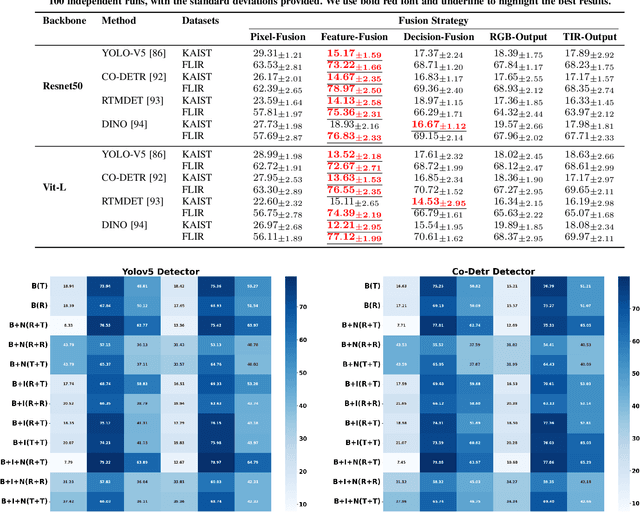

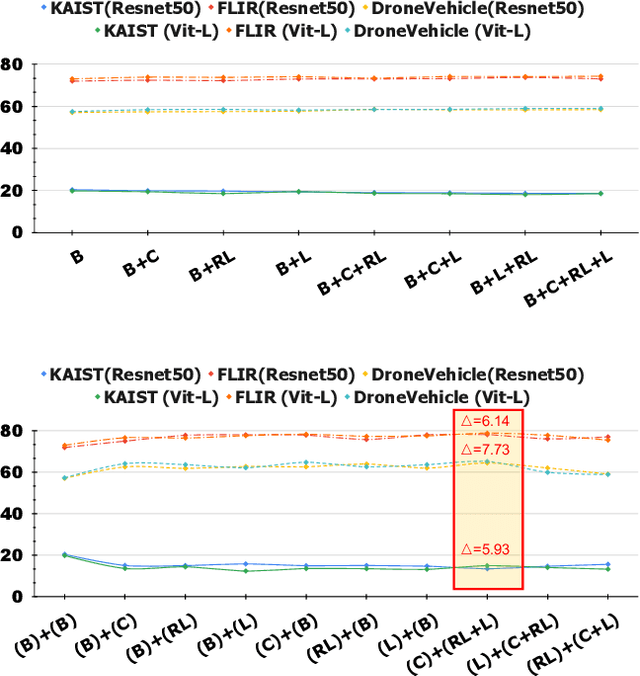
Abstract:Multispectral object detection, utilizing RGB and TIR (thermal infrared) modalities, is widely recognized as a challenging task. It requires not only the effective extraction of features from both modalities and robust fusion strategies, but also the ability to address issues such as spectral discrepancies, spatial misalignment, and environmental dependencies between RGB and TIR images. These challenges significantly hinder the generalization of multispectral detection systems across diverse scenarios. Although numerous studies have attempted to overcome these limitations, it remains difficult to clearly distinguish the performance gains of multispectral detection systems from the impact of these "optimization techniques". Worse still, despite the rapid emergence of high-performing single-modality detection models, there is still a lack of specialized training techniques that can effectively adapt these models for multispectral detection tasks. The absence of a standardized benchmark with fair and consistent experimental setups also poses a significant barrier to evaluating the effectiveness of new approaches. To this end, we propose the first fair and reproducible benchmark specifically designed to evaluate the training "techniques", which systematically classifies existing multispectral object detection methods, investigates their sensitivity to hyper-parameters, and standardizes the core configurations. A comprehensive evaluation is conducted across multiple representative multispectral object detection datasets, utilizing various backbone networks and detection frameworks. Additionally, we introduce an efficient and easily deployable multispectral object detection framework that can seamlessly optimize high-performing single-modality models into dual-modality models, integrating our advanced training techniques.
TableGPT2: A Large Multimodal Model with Tabular Data Integration
Nov 04, 2024Abstract:The emergence of models like GPTs, Claude, LLaMA, and Qwen has reshaped AI applications, presenting vast new opportunities across industries. Yet, the integration of tabular data remains notably underdeveloped, despite its foundational role in numerous real-world domains. This gap is critical for three main reasons. First, database or data warehouse data integration is essential for advanced applications; second, the vast and largely untapped resource of tabular data offers immense potential for analysis; and third, the business intelligence domain specifically demands adaptable, precise solutions that many current LLMs may struggle to provide. In response, we introduce TableGPT2, a model rigorously pre-trained and fine-tuned with over 593.8K tables and 2.36M high-quality query-table-output tuples, a scale of table-related data unprecedented in prior research. This extensive training enables TableGPT2 to excel in table-centric tasks while maintaining strong general language and coding abilities. One of TableGPT2's key innovations is its novel table encoder, specifically designed to capture schema-level and cell-level information. This encoder strengthens the model's ability to handle ambiguous queries, missing column names, and irregular tables commonly encountered in real-world applications. Similar to visual language models, this pioneering approach integrates with the decoder to form a robust large multimodal model. We believe the results are compelling: over 23 benchmarking metrics, TableGPT2 achieves an average performance improvement of 35.20% in the 7B model and 49.32% in the 72B model over prior benchmark-neutral LLMs, with robust general-purpose capabilities intact.
CRACKS: Crowdsourcing Resources for Analysis and Categorization of Key Subsurface faults
Aug 20, 2024



Abstract:Crowdsourcing annotations has created a paradigm shift in the availability of labeled data for machine learning. Availability of large datasets has accelerated progress in common knowledge applications involving visual and language data. However, specialized applications that require expert labels lag in data availability. One such application is fault segmentation in subsurface imaging. Detecting, tracking, and analyzing faults has broad societal implications in predicting fluid flows, earthquakes, and storing excess atmospheric CO$_2$. However, delineating faults with current practices is a labor-intensive activity that requires precise analysis of subsurface imaging data by geophysicists. In this paper, we propose the $\texttt{CRACKS}$ dataset to detect and segment faults in subsurface images by utilizing crowdsourced resources. We leverage Amazon Mechanical Turk to obtain fault delineations from sections of the Netherlands North Sea subsurface images from (i) $26$ novices who have no exposure to subsurface data and were shown a video describing and labeling faults, (ii) $8$ practitioners who have previously interacted and worked on subsurface data, (iii) one geophysicist to label $7636$ faults in the region. Note that all novices, practitioners, and the expert segment faults on the same subsurface volume with disagreements between and among the novices and practitioners. Additionally, each fault annotation is equipped with the confidence level of the annotator. The paper provides benchmarks on detecting and segmenting the expert labels, given the novice and practitioner labels. Additional details along with the dataset links and codes are available at $\href{https://alregib.ece.gatech.edu/cracks-crowdsourcing-resources-for-analysis-and-categorization-of-key-subsurface-faults/}{link}$.
TrajPRed: Trajectory Prediction with Region-based Relation Learning
Apr 10, 2024



Abstract:Forecasting human trajectories in traffic scenes is critical for safety within mixed or fully autonomous systems. Human future trajectories are driven by two major stimuli, social interactions, and stochastic goals. Thus, reliable forecasting needs to capture these two stimuli. Edge-based relation modeling represents social interactions using pairwise correlations from precise individual states. Nevertheless, edge-based relations can be vulnerable under perturbations. To alleviate these issues, we propose a region-based relation learning paradigm that models social interactions via region-wise dynamics of joint states, i.e., the changes in the density of crowds. In particular, region-wise agent joint information is encoded within convolutional feature grids. Social relations are modeled by relating the temporal changes of local joint information from a global perspective. We show that region-based relations are less susceptible to perturbations. In order to account for the stochastic individual goals, we exploit a conditional variational autoencoder to realize multi-goal estimation and diverse future prediction. Specifically, we perform variational inference via the latent distribution, which is conditioned on the correlation between input states and associated target goals. Sampling from the latent distribution enables the framework to reliably capture the stochastic behavior in test data. We integrate multi-goal estimation and region-based relation learning to model the two stimuli, social interactions, and stochastic goals, in a prediction framework. We evaluate our framework on the ETH-UCY dataset and Stanford Drone Dataset (SDD). We show that the diverse prediction better fits the ground truth when incorporating the relation module. Our framework outperforms the state-of-the-art models on SDD by $27.61\%$/$18.20\%$ of ADE/FDE metrics.
Perceptual Quality-based Model Training under Annotator Label Uncertainty
Mar 15, 2024Abstract:Annotators exhibit disagreement during data labeling, which can be termed as annotator label uncertainty. Annotator label uncertainty manifests in variations of labeling quality. Training with a single low-quality annotation per sample induces model reliability degradations. In this work, we first examine the effects of annotator label uncertainty in terms of the model's generalizability and prediction uncertainty. We observe that the model's generalizability and prediction uncertainty degrade with the presence of low-quality noisy labels. Meanwhile, our evaluation of existing uncertainty estimation algorithms indicates their incapability in response to annotator label uncertainty. To mitigate performance degradation, prior methods show that training models with labels collected from multiple independent annotators can enhance generalizability. However, they require massive annotations. Hence, we introduce a novel perceptual quality-based model training framework to objectively generate multiple labels for model training to enhance reliability, while avoiding massive annotations. Specifically, we first select a subset of samples with low perceptual quality scores ranked by statistical regularities of visual signals. We then assign de-aggregated labels to each sample in this subset to obtain a training set with multiple labels. Our experiments and analysis demonstrate that training with the proposed framework alleviates the degradation of generalizability and prediction uncertainty caused by annotator label uncertainty.
FOCAL: A Cost-Aware Video Dataset for Active Learning
Nov 17, 2023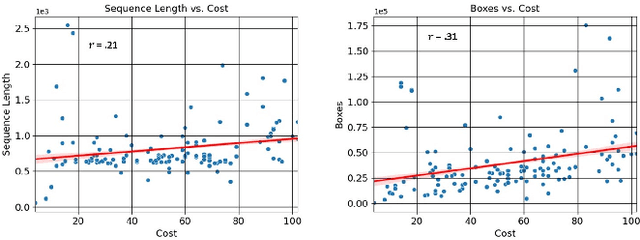
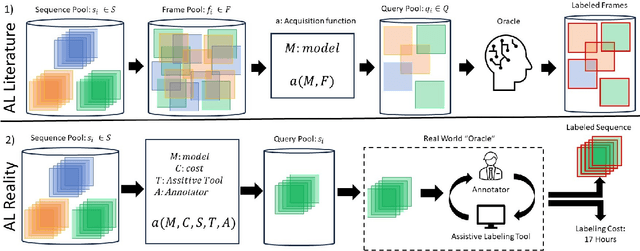
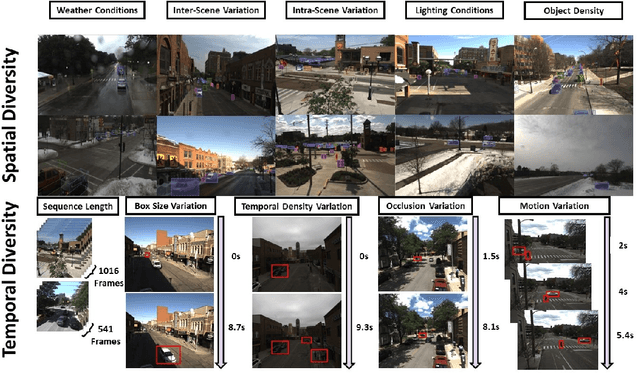

Abstract:In this paper, we introduce the FOCAL (Ford-OLIVES Collaboration on Active Learning) dataset which enables the study of the impact of annotation-cost within a video active learning setting. Annotation-cost refers to the time it takes an annotator to label and quality-assure a given video sequence. A practical motivation for active learning research is to minimize annotation-cost by selectively labeling informative samples that will maximize performance within a given budget constraint. However, previous work in video active learning lacks real-time annotation labels for accurately assessing cost minimization and instead operates under the assumption that annotation-cost scales linearly with the amount of data to annotate. This assumption does not take into account a variety of real-world confounding factors that contribute to a nonlinear cost such as the effect of an assistive labeling tool and the variety of interactions within a scene such as occluded objects, weather, and motion of objects. FOCAL addresses this discrepancy by providing real annotation-cost labels for 126 video sequences across 69 unique city scenes with a variety of weather, lighting, and seasonal conditions. We also introduce a set of conformal active learning algorithms that take advantage of the sequential structure of video data in order to achieve a better trade-off between annotation-cost and performance while also reducing floating point operations (FLOPS) overhead by at least 77.67%. We show how these approaches better reflect how annotations on videos are done in practice through a sequence selection framework. We further demonstrate the advantage of these approaches by introducing two performance-cost metrics and show that the best conformal active learning method is cheaper than the best traditional active learning method by 113 hours.
TableGPT: Towards Unifying Tables, Nature Language and Commands into One GPT
Aug 07, 2023



Abstract:Tables are prevalent in real-world databases, requiring significant time and effort for humans to analyze and manipulate. The advancements in large language models (LLMs) have made it possible to interact with tables using natural language input, bringing this capability closer to reality. In this paper, we present TableGPT, a unified fine-tuned framework that enables LLMs to understand and operate on tables using external functional commands. It introduces the capability to seamlessly interact with tables, enabling a wide range of functionalities such as question answering, data manipulation (e.g., insert, delete, query, and modify operations), data visualization, analysis report generation, and automated prediction. TableGPT aims to provide convenience and accessibility to users by empowering them to effortlessly leverage tabular data. At the core of TableGPT lies the novel concept of global tabular representations, which empowers LLMs to gain a comprehensive understanding of the entire table beyond meta-information. By jointly training LLMs on both table and text modalities, TableGPT achieves a deep understanding of tabular data and the ability to perform complex operations on tables through chain-of-command instructions. Importantly, TableGPT offers the advantage of being a self-contained system rather than relying on external API interfaces. Moreover, it supports efficient data process flow, query rejection (when appropriate) and private deployment, enabling faster domain data fine-tuning and ensuring data privacy, which enhances the framework's adaptability to specific use cases.
 Add to Chrome
Add to Chrome Add to Firefox
Add to Firefox Add to Edge
Add to Edge